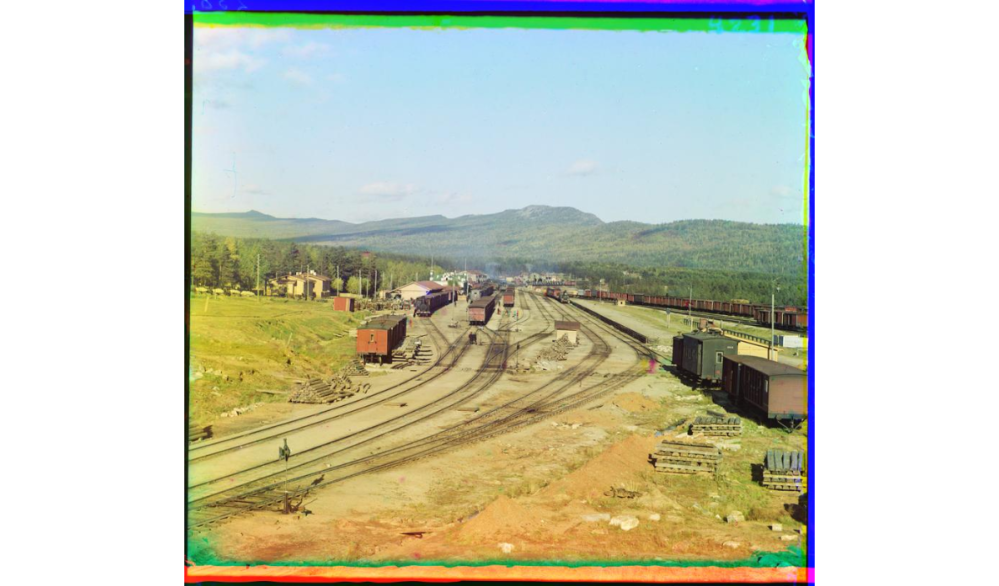By the middle of the 19th century, the Russian Empire found itself lacking in reform and by the start of the 20th century it found itself in a questionable circumstance. Imperial Russia was late to the game in the industrialized arena, but it did attempt to westernize itself. In the process, the introduction of new transportation systems such as the railroad helped connect the primarily agricultural society. The image below stood out to me because it was one of the few pictures that introduced elements of industrialization sought in Russia at the time.
Through scientific discovery, Sergei Mikhailovich Prokudin-Gorskii discovered a way to photograph images with a color presentation. Becoming a well-renowned artist, Tsar Nicholas II invited him to display his work for the imperial family. An impressed Nicholas would go on to finance a 10-year expedition in which Prokudin-Gorskii would photograph Russia in color, below is one of those images.

“Zlatoust Station” Sergei Mikhailovich Prokudin-Gorskii (1863–1944)
This image was what the town of Zlatoust looked like in September 1909. Founded in 1754, the town was known for its fishing and metalwork capabilities. Located in present-day Chelyabinsk Oblast, the town was photographed while Prokudin-Gorskii was exploring the railroads, industries, and natural scenes of the Ural Mountains. The town started to see an increase in manufacturing when a railroad line from Samara was completed in 1890, as well as the beginning of the Trans-Siberian Railway project in 1891.
In the picture you can clearly see many trains busy at work, but not to the extent of images seen in America and Europe at the time. Russia was faced with crippling economic issues as the concept of serfdom was coming to an end. To put the railway pictured above into perspective, during the American Civil War, images of vastly connected railways were photographed with advanced networks of commercial and industrial rail lines. At almost 50 years after the American Civil War, the Russian Empire still stood far behind the West when it came to industrial matters, making the reforms of Tsar Alexander II, Alexander III, and Nicholas II that much more important to the survival of the Russian Empire…![]()
If you would like to watch the blog post in a cinematic manner, I made a video version:
Sources
https://www.wdl.org/en/item/5281/#q=Prokudin-Gorskii
http://www.loc.gov/exhibits/empire/index.html
https://www.transsiberianexpress.net/trans-siberian-railway-history.html
Great title (and video)! The difference between the West and Russia at this time are very interesting, especially considering how quickly Russia rose to superpower status as the USSR. That a country so industrially behind was able to catch up so quickly is fascinating.
LikeLike
Nice post and video! Your comments about the difference between Russia and the West is an important theme throughout Russian history– Russia tends to feel inferior in terms of development, which leads to bigger scale changes, such as the revolution. The relationship between the West (US) and the USSR is well known, but I think you will be interested in the complexity of it throughout the class. Great work!
LikeLiked by 1 person
I really enjoyed your article (and even more-so with your video). It was a good idea to draw out different perspectives while discussing this topic, specifically the differences between the Russian Empire itself and the West. I’d like to see you do some more research into this topic and how it affected the future of the Russian Empire as a whole.
LikeLike
Star Wars and Boney M!?!?!??! You’ve made my week! Impressive. Really impressive.
LikeLike
This was a very creative article, and it was very entertaining and informative. Your commentary on just how undeveloped Russia was compared to it western neighbors, brings some questions to mind. For instance, I wonder if Russia’s development that had any direct effect on Russia and why its attempt at Marx style socialism lead to such horrific events. Or even you could ask just how power could Russia had been if it had modernized earlier and was more developed by the time the soviets took over, or would that new development have stopped the revolution.
LikeLike
How quickly the Soviet Union industrialized is nothing short of amazing. They went from having serfs bound to the land they worked on to a fully industrialized nation capable of beating back the Wehrmacht and giving the US a run for its money during the Cold War.
LikeLike
It’s interesting that one of the reasons for Russia’s fall was that it was trying to become a more developed nation like those in the West. The last desperate efforts of Tsar Nicholas II to improve his empire seemingly are what pushed it to the brink, but it is still incredible that Russia made as much progress as it did considering how large of an empire it was. The video was also great.
LikeLike
The connection you made to Star Wars really made me laugh! I thought this photo was especially interesting because it actually shows how the photographer used red, green, and blue film to create the colored images. I haven’t seen these streaks of color on his other photographs. I also really enjoyed how you compared the industrialization of Russia to the US to show how much more advanced one region of the world was to the other.
LikeLike